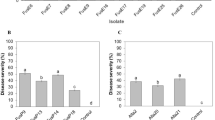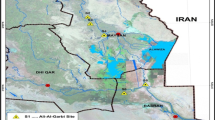Abstract
Wheat (Triticum aestivum L.) production in the warm areas of South Asia is severely affected by spot blotch caused by Cochliobolus sativus. There are several inoculum sources suspected to harbor C. sativus during the off season. This study was conducted to determine survival and potential sources of C. sativus inoculum from rice stubble, wheat seed, soil and weeds in three cropping systems (wheat-rice, wheat-fallow and wheat-green manure) during the 2004 and 2005 wheat growing seasons at Rampur, Nepal. Wheat seed, soil and rice stubble in the field, and weed plants in and around research plots were examined for the presence of the pathogen. Koch’s postulates were applied to verify representative strains. The pathogen was found in the wheat seed at moderate to high levels, but was absent in soil samples and rice stubble collected from the field before wheat was sown after rice. Weeds such as Blumea sp., Dichanthium annulatum, Digitaria ciliaris, Phalaris minor, Saccharum officinarum, Axonopus compressus, Brachiaria mutica, Eleusine coracana, Panicum sp., Paspalum scrobiculatum, Pennisetum purpureum, Setaria italica, Zea mays and Zizania aquatica harbored C. sativus. The C. sativus strains isolated from these weeds infected wheat by producing typical spot blotch symptoms. It is concluded that the weeds prevalent in different cropping sequences and on adjacent uncultivated land can serve as secondary hosts for C. sativus. This study presents important new information that could assist in better understanding spot blotch epidemiology and in developing integrated management strategies for spot blotch of wheat in the warmer growing regions of South Asia.
Article PDF
Similar content being viewed by others
Avoid common mistakes on your manuscript.
References
Alam, K.B., Shaheed, M.A., Ahmed, A.U., Malaker, P.K. 1994. Bipolaris leaf blight (spot blotch) of wheat in Bangladesh. In: Saunders, D.A., Hettel, G.P. (eds), Wheat in Heat-Stressed Environments: Irrigated, Dry Areas and Rice-Wheat Farming Systems. CIMMYT, Mexico, D.F., Mexico, pp. 339–342.
Bakonyi, J., Aponyi, I., Fischl, G. 1998. Diseases caused by Bipolaris sorokiniana and Drechslera tritici-repentis in Hungary. In: Duveiller, E., Dubin, H.J., Reeves, J., McNab, A. (eds), Helminthosporium blights of wheat: Spot blotch and tan spot. CIMMYT, Mexico, D.F., Mexico, pp. 80–87.
Dodman, R.L., Reinke, J.R. 1982. A selective medium for determining the population of viable conidia of Cochliobolus sativus in soil. Aust. J. Agric. Res. 33:287–291.
Dubin, H.J., Duveiller, E. 2000. Helminthosporium leaf blights of wheat: Integrated control and prospects for the future. In: Proceedings of the International Conference on Integrated Plant Disease Management for Sustainable Agriculture. Indian Phytopathological Society, New Delhi, India, pp. 575–579.
Duczek, L.J. 1981. Number and viability of conidia of Cochliobolus sativus in soil profiles in summer fallow fields in Saskatchewan. Can. J. Plant Pathol. 3:12–14.
Duveiller, E. 2004. Controlling foliar blights of wheat in the rice-wheat systems of Asia. Plant Dis. 88:552–556.
Duveiller, E., Gilchrist, L. 1994. Production constraints due to Bipolaris sorokiniana in wheat: Current situation and future prospects. In: Saunders, D.A., Hettel, G.P. (eds), Wheat in heat-stressed environments: Irrigated, dry areas and rice-wheat farming systems. CIMMYT, Mexico, D.F., Mexico, pp. 343–352.
Duveiller, E., Kandel, Y.R., Sharma, R.C., Shrestha, S.M. 2005. Epidemiology of foliar blights (spot blotch and tan spot) of wheat in the plains bordering the Himalayas. Phytopathol. 95:248–256.
Gilchrist, L.I. 1985. CIMMYT methods for screening wheat for Helminthosporium sativum resistance. In: Villareal, R.L., Klatt, A.R. (eds), Wheats for more tropical environments, Proceedings of an International Symposium, Mexico, 24–28 Sep 1984. CIMMYT, Mexico, D.F., Mexico, pp. 149–151.
Goulart, A.C.P. 1996. Transmission of Bipolaris sorokiniana from seeds to wheat coleoptile. Summa Phytopathologica 22:5–9.
Hossain, I., Azad, A.K. 1992. Reaction of wheat to Helminthosporium sativum in Bangladesh. Hereditas (Landskrona) 116:203–205.
Maraite, H., Di Zinno, T., Longrée, H., Daumerie, V., Duveiller, E. 1998. Fungi associated with foliar blight of wheat in warm areas. In: Duveiller, E., Dubin, H.J., Reeves, J., McNab, A. (eds), Helminthosporium blights of wheat: Spot blotch and tan spot. CIMMYT, Mexico, D.F., Mexico, pp. 293–300.
Mathieson, J.T., Rush, C.M., Bordovsky, D., Clark, L.E., Jones, O.R. 1990. Effects of tillage on common root rot of wheat in Texas. Plant Dis. 74:1006–1008.
Misra, A.P. 1973. Helminthosporium species occurring on cereals and other Gramineae. U.S.P.L. 480 Project No. A7-CR-133, Grant No. PGIN-223. Tirhut College of Agriculture, Bihar, India.
Neergaard, P. 1977. Seed Pathology. John Wiley & Sons, New York, USA.
Pandey, S.P., Kumar, S., Kumar, U., Chand, R., Joshi, A.K. 2005. Sources of inoculum and reappearance of spot blotch of wheat in rice-wheat cropping systems in eastern India. European J. Phytopathol, 111:47–55.
Piening, L.J., Orr, D. 1988. Effects of crop rotation on common root rot of barley. Can. J. Plant Pathol. 10:61–65.
Raemaekers, R.H. 1988. Helminthosporium sativum: Disease complex on wheat and sources of resistance in Zambia. In: Wheat production constraints in tropical environments. CIMMYT, Mexico, D.F., Mexico, pp. 175–186.
Reis, E.M. 1983. Selective medium for isolating Cochliobolus sativus soil. Plant Dis. 67:68–70.
Reis, E.M. 1991. Integrated disease-management — the changing concepts of controlling head blight and spot blotch. In: Saunders, D.A., Hettel, G.P. (eds), Wheat in heat-stressed environments: Irrigated, dry areas and rice-wheat farming system. CIMMYT, Mexico, D.F., Mexico, pp. 165–177.
Reis, E.M., dos Santos, H.P. 1987. The increased sporulation of Cochliobolus sativus on above-ground tissues of small grains and its relationship to the origin of inoculum in the soil. Fitopatologia Brasileira 12:206–208.
Saari, E.E. 1998. Leaf blight disease and associated soil-borne fungal pathogens of wheat in South and South East Asia. In: Duveiller, E., Dubin, H.J., Reeves, J., McNab, A. (eds), Helminthosporium blights of wheat: Spot blotch and tan spot. CIMMYT, Mexico, D.F., Mexico, pp. 37–51.
Sati, M.C., Dhyani, A.P., Khulbe, R.D. 1993. Seed-plant transmission of Drechslera sorokiniana in bean. Madras Agric. J. 80:33–36.
Schilder, A.M.C., Bergstrom, G.C. 1995. Seed transmission of Pyrenophora tritici-repentis, causal fungus of tan spot of wheat. Eur. J. Plant Pathol. 101:81–91.
Sharma, R.C., Kandel, Y.R., Duveiller, E., Shrestha, S.M. 2003a. Characterization of Helminthosporium leaf blight resistance in wheat at different growth stages. In: Rasmussen, J.B., Friesen, T.L., Ali, S. (eds), Proc. 4 th Int. Wheat Tan Spot and Spot Blotch Workshop. North Dakota State University, Fargo, USA. pp. 153–158.
Sharma, R.C., Shrestha, S.M., Duveiller, E. 2003b. Incidence of Bipolaris sorokiniana and Pyrenophora tritici-repentis on wheat in the lowlands of Nepal. In: Rasmussen, J.B., Friesen, T.L., Ali, S. (eds), Proc. 4 th Int. Wheat Tan spot and Spot Blotch Workshop. North Dakota State Univ, Fargo, USA. pp. 122–127.
Sharma, R.C., Duveiller, E. 2004. Effect of Helminthosporium leaf blight on performance of timely and late-seeded wheat under optimal and stressed levels of soil fertility and moisture. Field Crops Res. 89:205–218.
Sharma, S., Duveiller, E., Basnet, R., Karki, C.B., Sharma, R.C. 2005. Effect of potash fertilization on Helminthosporium leaf blight severity in wheat, and associated increases in grain yield and kernel weight. Field Crops Res. 93:142–150.
Sharma-Poudyal, D., Duveiller, E., Sharma, R.C. 2005. Effects of seed treatment and foliar fungicides on Helminthosporium leaf blight and on performance of wheat in warmer growing conditions. J. Phytopathol. 153:401–408.
Singh, R.V., Singh, A.K., Ahmad, R., Singh, S.P. 1998. Influence of agronomic practice on foliar blight, and identification of alternate hosts in the rice-wheat cropping system. In: Duveiller, E., Dubin, H.J., Reeves, J., McNab, A. (eds), Helminthosporium blights of wheat: Spot blotch and tan spot. CIMMYT, Mexico, D.F., Mexico, pp. 346–348.
Tinline, R.D. 1977. Multiple infections of sub-crown internodes of wheat (Triticum aestivum) by common root rot fungi. Can. J. Bot. 55:30–34.
Tinline, R.D., Spurr, D.T. 1991. Agronomic practices and common root rot in spring wheat: Effect of tillage on disease and inoculum density of Cochliobolus sativus in soil. Can. J. Plant Pathol. 13:258–266.
Whittle, A.M. 1977. Cochliobolus sativus on barley in Scotland. Plant Pathol. 26:67–74.
Wildermuth, G.B., McNamara, R.B. 1991. Effect of cropping history on soil populations of Bipolaris sorokiniana and common root rot of wheat. Aust. J. Agric. Res. 42:779–790.
Author information
Authors and Affiliations
Corresponding author
Additional information
Communicated by R.A. McIntosh
Rights and permissions
This article is distributed under the terms of the Creative Commons Attribution 4.0 International License (http://creativecommons.org/licenses/by/4.0/), which permits unrestricted use, distribution, and reproduction in any medium, provided you give appropriate credit to the original author(s) and the source, provide a link to the Creative Commons license, and indicate if changes were made.
About this article
Cite this article
Neupane, A.C., Sharma, R.C., Duveiller, E. et al. Sources of Cochliobolus sativus inoculum causing spot blotch under warm wheat growing conditions in South Asia. CEREAL RESEARCH COMMUNICATIONS 38, 541–549 (2010). https://doi.org/10.1556/CRC.38.2010.4.11
Received:
Accepted:
Published:
Issue Date:
DOI: https://doi.org/10.1556/CRC.38.2010.4.11




